-
Countries
-
Data and Analysis
-
Special Focus
-
Crisis Responses
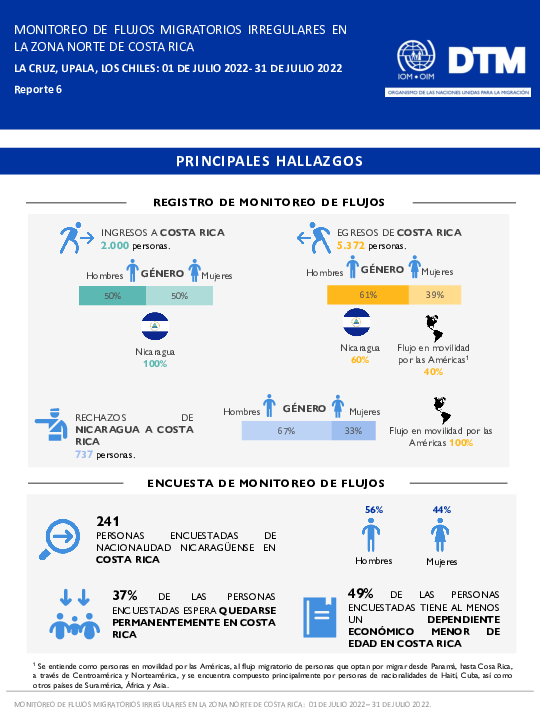
Contact
Angélica Madrigal amadrigal@iom.int
Language
Spanish
Location
Costa Rica
Period Covered
Jul 01 2022
Jul 31 2022
Activity
- Survey
- Registration
- Flow Monitoring
Desde el primero al 31 de Julio del 2022, se observaron un total de 7,373 personas que cruzaron irregularmente (ingresos y egresos) en los tres puntos de monitoreo de la frontera entre Costa Rica y Nicaragua, y 737 rechazos de Nicaragua a Costa Rica. . Estas encuestas se aplican a personas migrantes nicaragüenses en centros de agrupación y tránsito cotidiano, como terminales de autobuses o paradas de taxis informales.
Además, de un total de 282 personas a las que se les solicitó participar en la encuesta, de las cuales 241 accedieron, lo que significa que hubo una tasa de respuesta del 85 porciento Estas encuestas se aplican a personas migrantes nicaragüenses en centros de agrupación y tránsito cotidiano, como terminales de autobuses o paradas de taxis informales La recolección de información se ha realizado todos los días de la semana, entre 8 00 a m y 3 00 p m (desde 01 de julio al 31 de julio de 2022).
Estos datos son una medida dinámica para el recuento de personas que cruzan una frontera una o varias veces en un periodo establecido, no representan estimaciones generalizables del flujo migratorio irregular de Costa Rica por la frontera norte, por lo que deben interpretarse como un marco de referencia sobre las características de las personas migrantes irregulares de Costa Rica en un determinado periodo de tiempo y en determinados sitios de monitoreo.

Contact
DTM Burundi, DTMBurundi@iom.int
Language
French
Location
Burundi
Period Covered
Jan 01 2023
Jan 07 2023
Activity
- Mobility Tracking
- Event Tracking
Entre le 1 au 7 Janvier 2023, la DTM a identifié 991 personnes affectées dont 334 personnes déplacées par les pluies torrentielles et les vents violents.
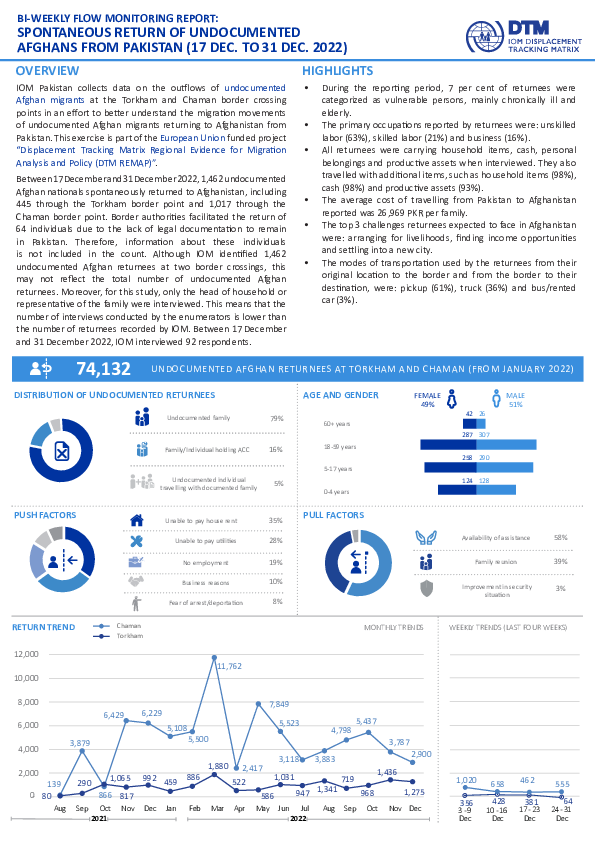
Contact
DTM Pakistan, iomisbdtmremapteam@iom.int
Language
English
Location
Pakistan
Period Covered
Dec 17 2022
Dec 31 2022
Activity
- Flow Monitoring
IOM Pakistan collects data on the outflows of undocumented Afghan migrants at the Torkham and Chaman border crossing points in an effort to better understand the migration movements of undocumented Afghan migrants returning to Afghanistan from Pakistan. This exercise is part of the European Union funded project “Displacement Tracking Matrix Regional Evidence for Migration Analysis and Policy (DTM REMAP)”.
Between 17 December and 31 December 2022, 1,462 undocumented Afghan nationals spontaneously returned to Afghanistan, including 445 through the Torkham border point and 1,017 through the Chaman border point. Border authorities facilitated the return of 64 individuals due to the lack of legal documentation to remain in Pakistan. Therefore, information about these individuals is not included in the count. Although IOM identified 1,462 undocumented Afghan returnees at two border crossings, this may not reflect the total number of undocumented Afghan returnees. Moreover, for this study, only the head of household or representative of the family were interviewed. This means that the number of interviews conducted by the enumerators is lower than the number of returnees recorded by IOM. Between 17 December and 31 December 2022, IOM interviewed 92 respondents.
Contact
DTM Somalia Location
Somalia
Activity
- Mobility Tracking
- Event Tracking
Period Covered
Dec 24 2022 -Dec 30 2022
ETT is a crisis-based tool that tracks sudden displacement triggered by specific events or emerging crises. The objective of ETT is to help prioritize humanitarian response and to enable partners to deliver rapid assistance. Based on previous drought induced displacement patterns, and the ones observed since the beginning of the drought, the humanitarian community expects that people will move from rural to urban areas in search of humanitarian services. Consequently, this ETT tool which concentrates only on drought induced displacements, focuses on the main urban centers and surrounding villages for each district. The data is collected through Key Informant Interviews (KIIs) at the location level, from Sunday to Wednesday every week. All locations assessed are monitored each week.
Population Groups
Survey Methodology
Unit of Analysis Or Observation
Type of Survey or Assessment
Keywords
Geographical Scope
Administrative boundaries with available data
The current dataset covers the following administrative boundaries
Contact
DTM Somalia Location
Somalia
Activity
- Mobility Tracking
- Event Tracking
Period Covered
Dec 17 2022 -Dec 22 2022
ETT is a crisis-based tool that tracks sudden displacement triggered by specific events or emerging crises. The objective of ETT is to help prioritize humanitarian response and to enable partners to deliver rapid assistance. Based on previous drought induced displacement patterns, and the ones observed since the beginning of the drought, the humanitarian community expects that people will move from rural to urban areas in search of humanitarian services. Consequently, this ETT tool which concentrates only on drought induced displacements, focuses on the main urban centers and surrounding villages for each district. The data is collected through Key Informant Interviews (KIIs) at the location level, from Sunday to Wednesday every week. All locations assessed are monitored each week.
Population Groups
Survey Methodology
Unit of Analysis Or Observation
Type of Survey or Assessment
Keywords
Geographical Scope
Administrative boundaries with available data
The current dataset covers the following administrative boundaries
Contact
iomyemendtm@iom.int
Location
Yemen
Activity
- Flow Monitoring Survey
- Flow Monitoring
Period Covered
Dec 01 2022 -Dec 31 2022
In December 2022, IOM Yemen DTM recorded 10,620 migrants entering Yemen, a 15 per cent increase compared to November 2022 (9,212). In Lahj (8,220 migrants) DTM has registered an increase in arrivals by 62 per cent compared to the last month (5,081 migrants). This stands in contrast to Shabwah (2,400) which registered a decrease this month by 42 per cent. In other terms, migration flows shifted from Bari, Somalia (-42%) towards Obock, Djibouti (+62%).
The overall increase could be linked to weather conditions, sea tides and decreased coast guard patrolling in Djibouti. While travel had been primarily due to economic reasons in the first half of the year, DTM has been recording conflict induced movements since August, being the reason for 19 per cent of all incoming movements in December. All conflict motivated travel was recorded in Shabwah coming from Bari, Somalia (23% children, 17% women and 60% men).
Due to the deteriorating humanitarian crisis in Yemen and the challenges in moving towards KSA, many migrants opted to return to the Horn of Africa. DTM teams in Djibouti recorded that during December 2022, a total of 583 migrants took the risky return by boat from Yemen to travel home. Moreover, DTM recorded 5,047 Yemeni returns from KSA during the month of December 2022, compared to 5,421 in November 2022.
Between 1 January and 31 December 2022, DTM recorded 73,233 migrants and 65,737 Yemeni migrant returnees to Yemen.
Population Groups
Survey Methodology
Unit of Analysis Or Observation
Type of Survey or Assessment
Keywords
Geographical Scope
Administrative boundaries with available data
The current dataset covers the following administrative boundaries
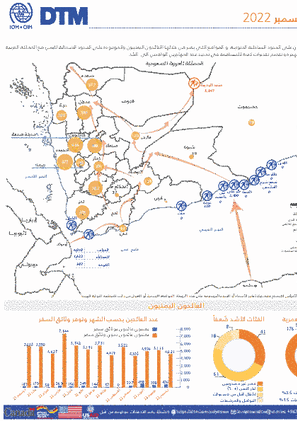
Contact
DTM Yemen, iomyemendtm@iom.int
Language
English
Location
Yemen
Period Covered
Dec 01 2022
Dec 31 2022
Activity
- Flow Monitoring
في ديسمبر 2022 ، سجلت مصفوفة تتبع النزوح (DTM) التابعة للمنظمة الدولية للهجرة في اليمن 10,620 مهاجرًا دخلوا اليمن ،بزيادة قدرها (%15) مقارنة بـ 9,212 مهاجرًا في نوفمبر 2022. في لحج (8,220 مهاجراً) سجلت مصفوفة تتبع النزوح زيادة في عدد الوافدين (+62%) مقارنة بالشهر الماضي (5,081 مهاجرا). على عكس محافظة شبوة (2,400 مهاجراً) التي شهدت انخفاضاً هذا الشهر بحوالي (-42%). أي ان تدفقات الهجرة هذا الشهر تحولت من باري ؛ الصومال (-42%) نحو اوبوك ؛ جيبوتي (+62%). ويمكن ربط الزيادة العام بالأحوال الجوية والمد البحري وانحفاض دوريات خفر السواحل في جيبوتي. في حين أن الهحرة كانت في المقام الأول لأسباب اقتصادية في النصف الأول من العام ، فإن مصفوفة تتبع النزوح كانت تسجل الصراع منذ أغسطس ، على انه السبب وراء هجرة 19 في المائة من جميع التحركات الواردة في ديسمبر. تم تسجيل جميع رحلات السفر بدافع الصراع في شبوة قادمة من باري ، الصومال (23٪ أطفال ، 17٪ نساء و 60٪ رجال).
بسبب الأزمة الإنسانية المتدهورة في اليمن والتحديات في المضي قدمًا نحو المملكة العربية السعودية ، اختار العديد من المهاجرين العودة إلى القرن الأفريقي. حيث سجلت فرق مصفوفة تتبع النزوح في جيبوتي خلال ديسمبر 2022 ، خوض 583 مهاجراً رحلة العودة الخطرة على متن قوارب من اليمن. بالإضافة إلى ذلك ، سجلت مصفوفة تتبع النزوح في اليمن حوالي 5,047 يمني عادوا من المملكة العربية السعودية خلال شهر ديسمبر، مقارنة بـ 5,421 في نوفمبر 2022. خلال الفترة بين 1 يناير و 31 ديسمبر 2022، وصل ما يقدر بـ 73,233 مهاجرًا و 65,737 يمنيًا عائداً إلى اليمن.
حيث مثل عدد المهاجرين من إثيوبيا97 % في المائة و ثلاثة في المائة من الصوماليين. كانت غالبية المهاجرين من الذكور (68) مع (14%) من النساء ، و تسعة في المائة من الأولاد وستة في المائة من الفتيات اللواتي كنا ايضاً من ضمن المسافرين.
خلال فترة التقرير في ديسمبر 2022، شوهد وصول 2,400 مهاجرا من الصومال وتم تسجيلهم في نقطة مراقبة التدفق بئر علي في محافظة شبوه. بينما شهدت نقاط مراقبة التدفق بمديرية المضاربة والعارة بمحافظة لحج وصول 8,220 مهاجرا وصلوا من جيبوتي , حيث تم تسجيل 6,010 في العزاف ؛ وا 1,623 في المخاباه ؛ وا 587 في الكوحه.

Contact
DTM Yemen, iomyemendtm@iom.int
Language
English
Location
Yemen
Period Covered
Dec 01 2022
Dec 31 2022
Activity
- Flow Monitoring
In December 2022, IOM Yemen DTM recorded 10,620 migrants entering Yemen, a 15 per cent increase compared to November 2022 (9,212). In Lahj (8,220 migrants) DTM has registered an increase in arrivals by 62 per cent compared to the last month (5,081 migrants). This stands in contrast to Shabwah (2,400) which registered a decrease this month by 42 per cent. In other terms, migration flows shifted from Bari, Somalia (-42%) towards Obock, Djibouti (+62%). The overall increase could be linked to weather conditions, sea tides and decreased coast guard patrolling in Djibouti. While travel had been primarily due to economic reasons in the first half of the year, DTM has been recording conflict induced movements since August, being the reason for 19 per cent of all incoming movements in December. All conflict motivated travel was recorded in Shabwah coming from Bari, Somalia (23% children, 17% women and 60% men).
Due to the deteriorating humanitarian crisis in Yemen and the challenges in moving towards KSA, many migrants opted to return to the Horn of Africa. DTM teams in Djibouti recorded that during December 2022, a total of 583 migrants took the risky return by boat from Yemen to travel home. Moreover, DTM recorded 5,047 Yemeni returns from KSA during the month of December 2022, compared to 5,421 in November 2022. Between 1 January and 31 December 2022, DTM recorded 73,233 migrants and 65,737 Yemeni migrant returnees to Yemen.
The migrant caseload was around 97 per cent Ethiopian nationals, and around three per cent Somali nationals. The migrants are predominantly male (73%), with (19%) women, five per cent boys and three per cent girls also among the travelers.
Through December’s reporting period, 2,400 migrants arrived from Somalia and were recorded at Ber Ali flow monitoring point in Shabwah governorate. In Lahj governorate, 8,220 migrants arrived from Djibouti, where 6,010 were recorded at Al Azaf flow monitoring point (FMP), 1,623 at Al Makhabbah FMP, and 587 at Al Cawhah FMP.
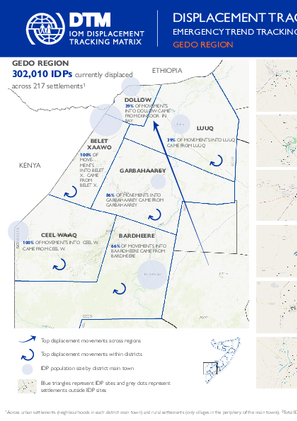
Contact
DTM Somalia, IOMSomaliaDTM@iom.int
Language
English
Location
Somalia
Period Covered
Dec 24 2022
Dec 29 2022
Activity
- Mobility Tracking
- Event Tracking
There are 302,010 individuals currenlty displaced by drought in Gedo region. Since round 42, an estimated 4,250 IDPs arrived at the assessed settlements.
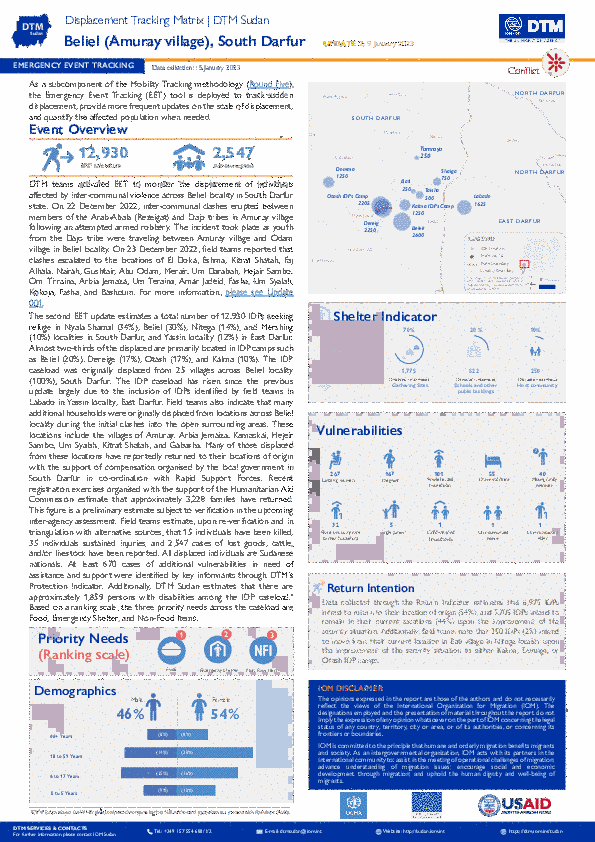
Contact
DTM Sudan; dtmsudan@iom.int
Language
English
Location
Sudan
Snapshot Date
Jan 05 2023
Activity
- Mobility Tracking
- Event Tracking
The DTM Emergency Event Tracking (EET) is deployed to track sudden displacement and population movements, provide more frequent updates on the scale of displacement, and quantify the affected population when needed. As a subcomponent of the new Mobility Tracking methodology in Sudan (Round Five), and activated on a need basis, EET utilises a broad network of key informants to capture best estimates of the affected population presence per location – a useful tool for humanitarian response planning and design.
